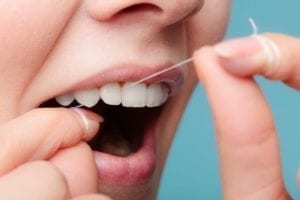Although brushing your teeth twice a day is an important part of preventing tooth decay and gum disease, if you aren’t flossing, you’re still at risk of oral health problems. Brushing only removes the bacteria that are easiest to reach on the surface of the teeth, but much of the plaque lives between the teeth. Plaque creates a fertile environment for bacteria to begin eating away at tooth enamel, exposing the tissues inside the teeth. At all Bella Smiles locations, we convey just how important flossing is for your oral health.
Why Is Flossing So Important?
This where flossing can make a big difference. Flossing removes the plaque that your toothbrush can’t easily reach in places like between your teeth. However, it is very important that you are effectively flossing: As they say, an ounce of prevention is worth a pound of cure, and flossing is that ounce of prevention where tooth decay is concerned, helping you to avoid painful, time-consuming, and potentially costly restorative dental procedures that can become necessary when tooth decay is allowed to flourish unchecked between teeth.
How to Floss Correctly
- Wrap around your middle fingers a length of floss about eighteen inches long. Use your thumbs and forefingers to move the floss. You should wind more around one finger than the other so you can wind the already used floss toward the finger with less floss wrapped around it and access a fresh length.
- Push the floss between two teeth and use a gentle “sawing” (back and forth) motion all the way from the top of the teeth down to their base where they erupt from your gums.
- Wrap the floss around the side of one tooth in a “U” shape then gently slide up and down your tooth. Repeat this several times, making sure to go slightly underneath the gum-line, then repeat on the other side of the tooth. Do this for each tooth.
- Again be sure to wind up the floss around your finger so you’re using a clean length of floss for each space between your teeth that you floss. Bacteria that have been removed on floss can linger and make you sick if reintroduced later
- Don’t worry too much if you see that your gums are bleeding as you floss. A little bleeding is perfectly normal if you don’t floss regularly. This bleeding is due to inflammation caused by the bacteria dwelling there. If you floss daily as recommended by your dentist, you should see an improvement in the health of your gums in one to two weeks.
What About Floss Picks?
Some patients prefer to use floss picks. These “Y” shaped pieces of plastic with floss strung between the arms of the “Y” are widely available at most stores. However, dentists prefer using a length of real floss and your hands. Floss picks don’t allow for proper flossing due to the fact that you cannot wrap them around a tooth in the “U” shape recommended. However, it’s still better than not flossing at all.
Schedule An Appointment With Your Dentist
If you have any additional questions about brushing, flossing, or your oral health, call us or schedule an appointment at our Roslyn, Riverhead, or Nesconset locations.
